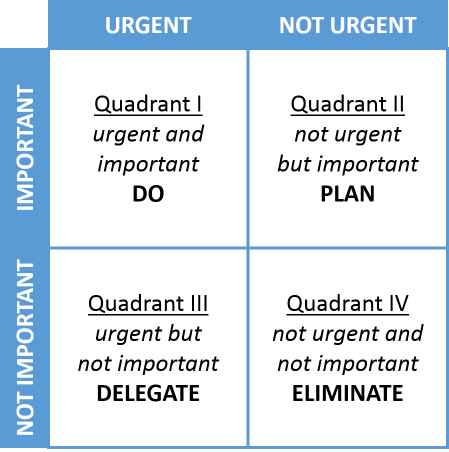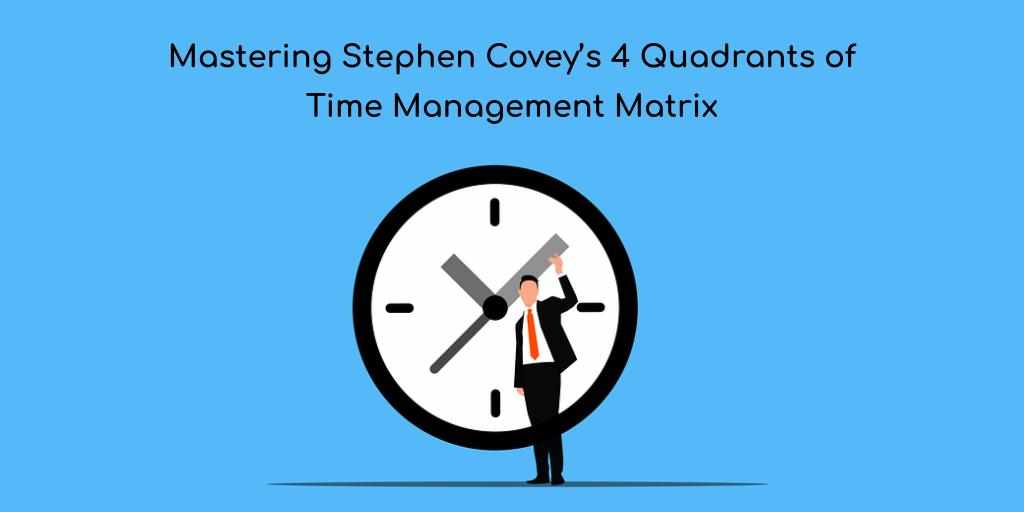Introduction
Effective time management is crucial in today’s fast-paced world, where demands and responsibilities seem to be ever-increasing. One prominent figure in the field of time management is Stephen Covey, a renowned author, speaker, and educator. Covey’s principles and frameworks have helped countless individuals enhance their productivity and achieve a better work-life balance.
In this article, we delve into Covey’s influential concept known as the Time Management Matrix, providing a comprehensive understanding of its principles and practical strategies to optimize your time utilization.
Understanding the Time Management Matrix
The Time Management Matrix is a four-quadrant framework that categorizes tasks based on their urgency and importance. By organizing tasks into these 4 quadrants, individuals can prioritize their efforts more effectively and allocate their time in a manner that aligns with their goals and values.
Quadrant 1: Urgent and Important Tasks
Quadrant 1 represents tasks that require immediate attention and are crucial for personal or professional success. These tasks often involve deadlines, crises, or pressing issues that demand immediate resolution. Examples include imminent project deadlines, urgent client requests, or unexpected emergencies. Focusing on Quadrant 1 tasks is essential to avoid negative consequences and maintain stability.
Quadrant 2: Not Urgent but Important Tasks
Quadrant 2 encompasses tasks that are important for long-term success but lack immediate deadlines. These tasks often involve personal development, strategic planning, relationship building, and proactive problem-solving. By dedicating more time to Quadrant 2, individuals can prevent tasks from becoming urgent in the future and ensure they are investing their efforts in activities that align with their values and goals.

Image Source: Wikipedia
Quadrant 3: Urgent but Not Important Tasks
Quadrant 3 represents tasks that are urgent but do not contribute significantly to long-term goals or personal growth. These tasks are often distractions, interruptions, or unnecessary requests from others. Examples include unimportant phone calls, excessive emails, or trivial meetings. While some Quadrant 3 tasks may require attention, it is essential to minimize their impact on valuable time and delegate or eliminate them whenever possible.
Quadrant 4: Not Urgent and Not Important Tasks
Quadrant 4 comprises tasks that offer little to no value and merely serve as time-wasting activities or entertainment. These tasks can include excessive social media scrolling, watching mindless videos, or engaging in idle gossip. Spending excessive time in Quadrant 4 detracts from more important endeavors and hinders productivity and personal growth. It is crucial to limit Quadrant 4 activities to maintain focus and maximize efficiency.
Benefits of Utilizing the 4 Quadrants of Time Management Matrix
Implementing the 4 Quadrants of Time Management Matrix provides numerous benefits that can significantly impact productivity and overall well-being. Let’s explore some of the advantages gained by leveraging this framework:
- Increased productivity: By focusing on Quadrant 2 tasks and minimizing time spent on Quadrant 3 and 4 activities, individuals can enhance their productivity and achieve more meaningful outcomes in both personal and professional domains.
- Enhanced focus on important tasks: The Time Management Matrix encourages individuals to prioritize tasks based on importance rather than urgency alone. This shift in mindset enables individuals to allocate their time and resources to tasks that align with their long-term goals and values.
- Reduced stress and overwhelm: By effectively managing urgent tasks in Quadrant 1 and dedicating time to proactive planning and personal development in Quadrant 2, individuals experience reduced stress levels and a greater sense of control over their responsibilities.
- Improved decision-making abilities: The Time Management Matrix promotes a structured approach to decision-making by considering both urgency and importance. This enables individuals to make more informed choices about task prioritization, resource allocation, and overall time management.
- Better work-life balance: By consciously allocating time to Quadrant 2 tasks, such as personal well-being, family, and recreation, individuals can achieve a healthier work-life balance, leading to increased satisfaction and overall happiness.
Strategies for Implementing the Time Management Matrix
While understanding these 4 quadrants of urgent important matrix is crucial, practical implementation is equally important for reaping its benefits. Here are some strategies to effectively utilize the framework:
- Self-reflection and awareness: Begin by reflecting on your current time utilization habits and identifying areas for improvement. Develop self-awareness regarding your tendencies, distractions, and time-wasting activities. This awareness serves as the foundation for change.
- Prioritization and goal setting: Clearly define your goals, both short-term and long-term. Align your tasks with these goals and prioritize them accordingly. Setting clear priorities allows you to focus your time and energy on tasks that contribute to your desired outcomes.
- Time blocking and scheduling: Utilize time-blocking techniques to allocate specific time slots for different tasks and activities. By scheduling dedicated time for Quadrant 2 tasks and minimizing interruptions during these periods, you can ensure progress in important areas.
- Delegation and outsourcing: Identify tasks that can be effectively delegated to others or outsourced. By leveraging the skills and expertise of others, you free up valuable time for tasks that align with your core competencies and require your personal attention.
- Setting boundaries and saying no: Learn to set boundaries by saying no to tasks that do not align with your priorities or values. Respectfully decline requests or delegate them to others when appropriate. Setting boundaries allows you to maintain focus and protect your time.
- Reviewing and adjusting regularly: Regularly review your time management practices and assess their effectiveness. Make adjustments and refinements as needed to ensure continuous improvement. Adaptability is key to optimizing your time utilization.
Case Studies and Examples
To provide concrete examples of the Time Management Matrix in action, let’s explore a few case studies:
Case Study 1: John, a marketing executive, identified that he was spending significant time in Quadrant 3, attending non-essential meetings and responding to unnecessary emails. By implementing the Time Management Matrix, he started prioritizing important tasks (Quadrant 2) such as strategic planning, client relationship-building, and skill development. As a result, John noticed a significant increase in productivity, improved work quality, and more time available for innovative initiatives.
Case Study 2: Sarah, a small business owner, often found herself overwhelmed with urgent client demands (Quadrant 1) and struggled to find time for her own professional growth. By adopting the Time Management Matrix, Sarah started allocating dedicated time to Quadrant 2 activities, such as market research, competitor analysis, and exploring new business opportunities. This shift allowed her to proactively address client needs, minimize last-minute crises, and expand her business successfully.
Case Study 3: Alex, a busy parent, was constantly juggling multiple responsibilities, leaving little time for personal well-being or quality time with family (Quadrant 2). By embracing the Time Management Matrix, Alex began blocking specific times for self-care activities, family outings, and quality bonding time. This change not only improved Alex’s overall happiness but also positively impacted their productivity and focus when engaged in work-related tasks.
These case studies highlight the transformative power of the Time Management Matrix in diverse contexts. By consciously implementing its principles, individuals can optimize their time utilization and achieve remarkable outcomes.
Common Challenges and How to Overcome Them
While implementing the Covey’s 4 Quadrants of Time Management Matrix, individuals may encounter certain challenges. Below are some common barriers and strategies to overcome them:
- Procrastination and distractions: Procrastination can hinder progress on important tasks. Combat this by breaking down tasks into smaller, manageable steps, utilizing time-blocking techniques, and minimizing distractions such as social media notifications or unnecessary interruptions.
Do you know there is actually a way to become a productive procrastinator and you can use procrastination to your advantage? - Difficulty in determining task importance: Assessing task importance can sometimes be subjective. To overcome this, establish clear criteria for evaluating task significance, consider long-term implications, seek input from mentors or trusted colleagues, and align tasks with your overarching goals.
- Dealing with unexpected emergencies: While the Time Management Matrix aims to reduce emergencies, they can still arise. Maintain flexibility in your schedule to accommodate unexpected situations, delegate when possible, and adapt your priorities accordingly. Being prepared for unforeseen circumstances minimizes their impact on your overall productivity.
- Lack of discipline and consistency: Adhering to new time management practices requires discipline and consistency. Create accountability mechanisms, such as sharing goals with an accountability partner or using productivity apps that track your progress. Celebrate small wins and milestones to stay motivated and committed to the process.
- Overcoming resistance to change: Change can be challenging, especially when ingrained habits are involved. Reflect on the benefits of adopting the Time Management Matrix, seek support from like-minded individuals, and remind yourself of the positive impact it will have on your productivity, well-being, and success.
Tools and Resources for Time Management
Various tools and resources can support your journey toward effective time management. Consider utilizing the following:
- Digital and mobile apps: Time-tracking apps, task management tools, and calendar applications can help streamline your time management efforts. Popular options include Trello, Todoist, Asana, Google Calendar, and RescueTime.
- Productivity techniques and frameworks: Explore productivity methodologies such as the Pomodoro Technique, Eisenhower Matrix, Getting Things Done (GTD), or the 80/20 rule (Pareto Principle). Experiment with these frameworks and identify the ones that resonate with your working style and preferences.
- Time tracking and analytics tools: Tools like Toggl, Clockify, or Harvest enable you to track your time spent on different tasks and gain insights into your productivity patterns. Analyzing this data helps identify areas for improvement and highlights time sinks that can be optimized.
- Books and resources on time management: Dive deeper into time management principles by reading books like “The 7 Habits of Highly Effective People” by Stephen Covey, “Deep Work” by Cal Newport, or “Atomic Habits” by James Clear. These resources offer valuable insights and practical strategies to enhance your time management skills.
Conclusion
The Time Management Matrix, pioneered by Stephen Covey, offers a powerful framework for optimizing time utilization and achieving greater productivity. By understanding the four quadrants and implementing the strategies discussed in this article, individuals can gain control over their time, focus on important tasks, reduce stress, and improve work-life balance.
Remember, effective time management is an ongoing process that requires self-awareness, discipline, and regular evaluation. Embrace these 4 quadrants of Time Management Matrix, and unlock your potential to accomplish more while enjoying a fulfilling and balanced life.




Thank you for another wonderful post. Where else may anyone get that kind of info in such a perfect way of writing? I have a presentation next week, and I’m on the look for such info.